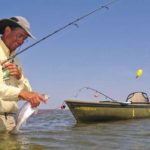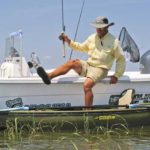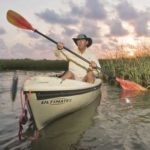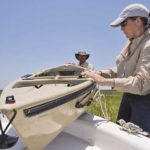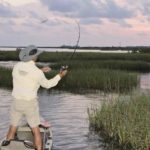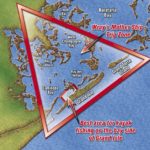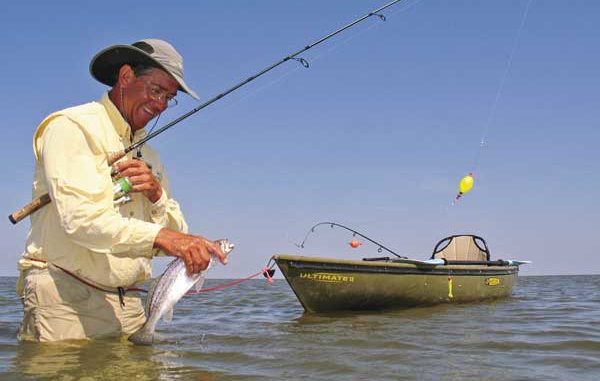
Catching trout and reds from kayaks is a sport that’s booming in popularity, especially now when anglers need a bank loan to fill up their fuel tanks.
Most people try to escape the corporate world by going fishing. Unfortunately, many in the fishing world are finding it becoming more and more like the corporate world every day. When the measure of a fishing trip is based more on the bottom line than it is the total experience, something just doesn’t seem right.
In saltwater fishing, the bottom line is measured in numbers of fish rather than numbers of dollars. The never-ending search for limits is just as stressful on the guides who have to produce them as the never-ending search for clients is to the salesmen who have quotas to meet.
I thought work was for people who don’t fish, not for people who want to fish. I guess the great thing about fishing, though, is that anglers can pursue it at any level that fits their personalities. If somebody wants to trade the stress of big business for the stress of looking for limits, that’s their call.
However, there are those whose personalities just won’t allow them to make fishing feel like work. These are the anglers who are content to wade a creek for catfish, drift a stream for spotted bass or walk a pond for a perch or two. These folks have made a conscious decision to fish on their terms, not the 12-year easy-financing terms of the corporate world.
Among the fastest-growing cults of angling personalities on the water today are those who would rather fish all day on a gallon of Kool-Aid than 50 gallons of gasoline. Their arms provide their power, and their kayaks provide their platforms.
For many kayakers, the thrill of fishing is in finding that overlooked pond that no others have fished, getting pulled around by a big red and landing enough fish for lunch. The possibility of limits are there, but limits aren’t the name of the game for kayakers — their personalities just won’t allow it.
One personality that inadvertently fell into the world of kayak fishing is Capt. Danny Wray from Grand Isle. Wray became aware of the sensibility of fishing out of a kayak in a Texas surf shop as his eyes fixated on a display model hanging on the wall.
“I remember walking up to it and touching it,” Wray said. “I turned around to Kristen (his wife) and told her I didn’t want it — I had to have it. In fact, I bought two of them that day, and the next day I confirmed what I already knew. Fishing out of a kayak fit my personality as an angler.”
Danny and Kristin Wray soon opened Calmwater Charters on Grand Isle, and the husband-and-wife team discovered that the marsh north of Grand Isle and the surf to the south were ideal locations to fish from a kayak.
Not only was the allure of launching the small craft and fishing only under paddle power tempting to their clients, they soon realized that loading up their kayaks in their bay boat and heading to locations too far to reach was a great way to explore secret shallow spots that essentially were unfishable in anything but a kayak.
“That’s how our Mother Ship trip came to be,” said Danny Wray. “This trip opens up thousands of acres of water that most of it’s never seen a kayak as opposed to the typical places that get launched on all the time.
“It’s nice during the summer to go to Google Earth and find some of the stuff around, say, Four Bayous and then head over there to do some exploring. It just adds a lot of adventure to fishing, and you get the feeling that you’re fishing untouched fish.”
Anglers who launch their kayaks at Grand Isle have a somewhat limited, although extremely productive, stretch of the north side of the island to fish. This stretch is easily identifiable on most any overhead map, as it is the only stretch that looks like marsh grass. All the rest of the north side of the island is either industrial or residential property.
“What makes this stretch the best kayak fishing is that it’s the only stretch that is still covered with marsh,” said Danny Wray. “It starts about a mile in from the west end of the island, and it runs about 2 miles to the east. It essentially runs from our place to the new Wildlife and Fisheries building, and any kayak angler could launch at the west end of the island and be able to comfortably fish this area.”
Kristin Wray says this stretch of Grand Island offers excellent redfish during the winter, but very little trout fishing since many of them are farther north in the Barataria system. Things change during the summer, though, as trout push their way toward the coast to spawn.
“Grand Isle gets some large trout during the summer months,” she said, “but many of those are found on the surf side, which is difficult to fish when the prevailing southeast winds rough it up. We catch a lot of trout on the north side of the island, but most of them would be considered school trout. What they lack in size, though, they make up for in quantity. It’s a lot of 12- to 15-inch fish, but we get an occasional 18- or 19-inch trout.”
While paddling the north side of Grand Isle is what kayak angling is all about in its purest form, the vast Barataria system makes many kayakers wonder, “What if?”
What if they could paddle such a long way? What if they could handle the logistics of such a long trip? What if they got out there and found the fishing so fantastic that they didn’t want to return?
That’s where the Wray’s Mother Ship trip comes in. In a way, if you’re of the same personality as they, you’re always looking for the angling equivalent of the Holy Grail — an oyster-bottomed clear-water lagoon where you never have to worry about running up on a crowd.
“We take the kayaks out to the north, south, east and west,” Wray said. “You wouldn’t think we had too many places to go to the south, but you can fish the beach from the kayaks, and we have plans to head out this summer to some of the rig fishing and some rip fishing for mahi-mahi.”
Danny Wray likes to plan each trip according to what the anglers want. He’ll get in a kayak and fish near novice anglers who are still in the learning stages. He’ll drop off kayakers and hang around in his bay boat until they’re ready to move, and he serves as an on-the-water taxi service for those who just want a ride.
“We’ve actually done trips that start at Williams Canal over by Highway 1 then bounced up to Golden Meadow and end up at Grand Terre,” said Kristin Wray. “Basically, in about six hours, we can get about three spots in, whereas in a bay boat trip you probably get about 12 shots in at different spots.”
Danny Wray says the advantage to kayak fishing spots like these that might be just as easily fished from a bay boat is stealth. To prove his point, Wray put me into a kayak, and we both paddled to a small canal on the backside of Grand Isle. A large bay boat was fishing one of the points of the canal as we paddled to the back.
We started fishing our way out toward the boat, which, by the way wasn’t too successful on the point, and we picked up a trout here and there. By the time we got to the point, we had already caught and released several trout in the 12- to 14-inch size range.
“When you’re in a kayak, you don’t make any hull noise or a whole bunch of racket,” he said as we paddled back to his dock. “You can basically let the wind blow you right over fish, and turn around and fish them. There’s no trolling motor noise. It’s the stealth of it that allows you to catch fish that may not bite after you go roaring in to a spot with a big boat.”
Another thing Danny Wray said beginners should be aware of is that their chosen fishing platform tends to change directions a lot. It’s stable, but he encourages people to lose the concept that the boat has to be in the perfect position. Casting becomes more a flick of the wrist than a heave-ho with the arms.
That’s one of the reasons he encourages kayak anglers to gear up with medium-action spinning rods and reels. While spinning gear may not be your favorite, its ability to allow you to cast a long way with just a flick of the wrist makes it ideal for kayak angling.
Kayak anglers also need to get in the mindset that paddling and casting at the same time like you might troll down a bank is nearly impossible. Rather than fight the boat the entire time he’s on the water, Danny Wray employs an old small-game-hunting strategy to maximize his time on the water and keep his frustrations to a minimum.
“I tell anglers to let the wind guide them more so than their paddle,” he said. “Use the paddle to get where you’re going, but once you get to your spot, let the wind work to your advantage. Paddle to a spot where the wind will move you across your fishing area. Once it blows you across, paddle back and do it again. It’s kind of like squirrel hunting — pick you a good tree and go sit under it a while.”
Being so low to the water seems a little unnatural the first time anglers try kayak fishing. They find much of their leverage from being high atop the deck of a bay boat is gone, and they are left wondering how they are going to detect strikes and set the hook.
During my venture into the world of kayak fishing, I found that hanging a soft plastic under a popping cork was ideal for fishing from such a low profile because they are easy to work with the rod pointed up in the air, and their visual indication of a strike made it even better.
“Topwaters are also great for kayak fishing,” said Danny Wray. “Any of the surface lures that walk can be fished with the rod up in the air, and you still get that visual indicator of a strike. With some time, though, you’ll find that you can just as easily bump a jig on the bottom and be very comfortable with feeling a bite and setting the hook.”
Calmwater Charters operates within about a 10-mile radius from Grand Isle with a 4- or 5-mile range to the north, but not much farther than the Twin Pipelines because most of the fish are in the big bays and open water. To the west, they go as far as the Belle Pass rock jetties and maybe Timbalier under ideal conditions. To the east, Wray goes as far as the Four Bayou area.
Since they began kayak fishing a few years ago, Danny and Kristin Wray have seen the popularity of the sport skyrocket. And with the price of fuel rising to unprecedented heights, they believe interest in kayak fishing is only going to grow.
“Plus there’s so much autonomy in owning a little boat that you can throw in the back of your truck, put two tie downs on it, go down the road and drop it in any little puddle of water you find,” Kristin Wray said. “There’s just so much freedom, and the lack of maintenance and the low overhead make it a huge plus.”
However, with the diminished range of a kayak, anglers should tone down their expectations of how many fish they’re going to catch. The opportunity is there to catch lots of fish, but many kayak anglers are perfectly happy with a few trout and a couple of redfish.
“The great thing about it, though, is that fishing from a kayak tends to make you a better angler because the temptation to crank the motor and move to another spot is gone,” Danny Wray said. “It’s going to teach you how to catch fish off the structure or water that you have, how to read current, how to notice baitfish. You can learn a lot when you’re forced to sit still and be patient.”
If you’re ready to make a jump from the stressful world of catching limits of speckled trout, there’s no better place to land than in the seat of a kayak. I think you’ll find that it fits your personality and your pocketbook.
Whether you launch it at Grand Isle and fish on your own, throw it in the bottom of Danny and Kristin Wray’s boat or paddle it to any number of destinations across coastal Louisiana, you’re going to be secretly sucked into this new cult of angling personality.
Have all the Kool-Aid you want.
Danny and Kristin Wray can be reached at 225-634-5034 or www.calmwatercharters.net.
